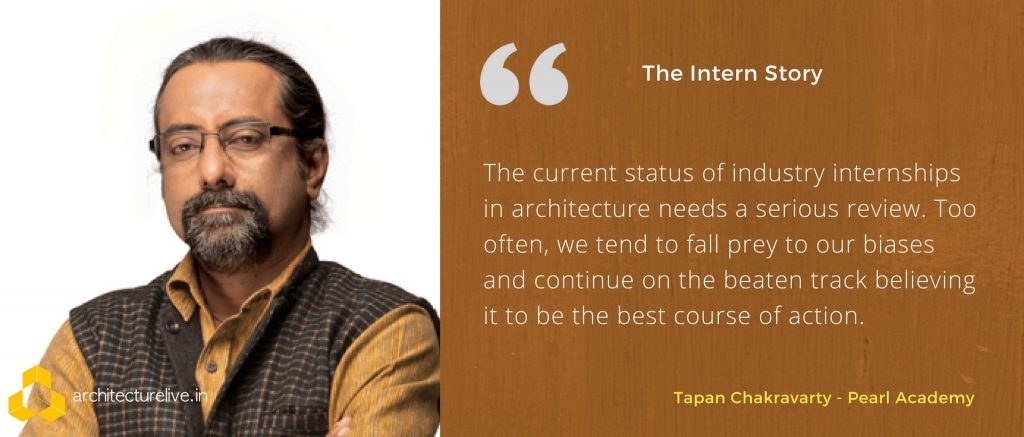Student internship is a quintessential part of an architectural education. However, it is increasingly becoming an unmitigated ordeal for many within the community. Affecting both students and practicing architects, the workforce imbalance and issues of ineptitude have created an unfavourable – and often exploitative – situation.
Inviting the opinions of architects, educators and students, we strive to start a conversation about what can be done to improve this situation. Below, Tapan Chakravarty, Senior Professor at Pearl Academy, ponders upon the feasibility of including internship in architectural education.

Industry Internship has become an inseparable part of Architectural Education. In fact, it has become nearly impossible to conceive of a five years Bachelor’s degree program without the Internship module being an integral part of the curriculum. Even Post-Grad/Masters programs in the discipline often try to insert an Internship module within their packed 2-year schedule – sometimes even as a 4-8 weeks compulsory exercise, consuming the much awaited vacations.
In the B.Arch. program, this Internship module has increasingly become a matter of concern. Its usefulness – as a reality or a formality – is under debate. This is accompanied by discussions regarding whether the Internship module should be placed in the semester 7, 8, 9, or 10, and whether its duration should be one semester or two. The inconclusive nature of these debates indicates a lack of clarity on the real purpose and perception of Internship within the curriculum, and calls for some soul-searching.
In India, as the B.Arch degree auto-fetches the registration with the CoA (and a license to practice), internship modules have become a curricular necessity. This necessity is in trouble as more and more prospective interns step out with their applications, when there aren’t enough quality architecture firms to absorb them and offer good exposure and mentorship. Corrupt practices are obvious, and unscrupulous members on both sides take advantage of the situation. The academic institutions do not take any responsibility in these cases, despite most of them collecting fees during this time and toting the module as an academic proposition.
Exploring the Nuance of Work Experience
The current status of industry internships in architecture needs a serious review, but this can only be done if we shed some of our conventional prejudices. Too often, we tend to fall prey to our biases and continue on the beaten track believing it to be the best course of action. We may also wish to differentiate between training, internship, apprenticeship, articleship, etc. so we can establish the current needs of the discipline regarding them. We often gloss over words/phrases with the blind belief that these don’t matter, which isn’t always the case.
Are we prepared to look at Education as different from Training? Are we prepared to accept that not every B.Arch. graduate is necessarily looking for a career in Industry Practice? Are we prepared to accept that Industry Internship may also be different from working as an Article with an architectural firm? Are we prepared to see Internship as an opportunity and a choice for the student to explore the limits/expanse of Architecture? Are we prepared to see Apprenticeship, rather than Internship, as being inherent to professional and industry practice? Are we prepared to detach the Academic Degree from the CoA Registration – taking it, instead, as only one of the pre-requisites for a license to practice?
We do need to debate the relationship between Education and Practice in the larger domain of Architecture. However, we need to widen our perspective on Education and Literacy itself, first.
 Tapan K. Chakravarty is an architect, urban designer and an educator. Presently, he is a Senior Professor and Area Head at the Pearl Academy. Previously he has been Professor and Dean at Sushant School of Art & Architecture, Gurgaon, and the Head of Department of Interior Architecture & Product Design at Pearl Academy across four campuses. He has also been Faculty, Mentor & Examiner at several Institutes of Architecture/Design in Delhi & NCR for over thirty years. Professionally engaged, since 1984, with a number of established Architecture/Urban Design firms in Delhi and organizations like UNDP and INTACH, besides having own practice till recently; he is now full-time in education.
Tapan K. Chakravarty is an architect, urban designer and an educator. Presently, he is a Senior Professor and Area Head at the Pearl Academy. Previously he has been Professor and Dean at Sushant School of Art & Architecture, Gurgaon, and the Head of Department of Interior Architecture & Product Design at Pearl Academy across four campuses. He has also been Faculty, Mentor & Examiner at several Institutes of Architecture/Design in Delhi & NCR for over thirty years. Professionally engaged, since 1984, with a number of established Architecture/Urban Design firms in Delhi and organizations like UNDP and INTACH, besides having own practice till recently; he is now full-time in education.







